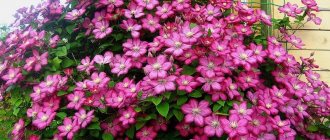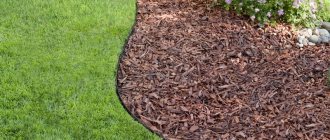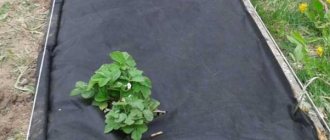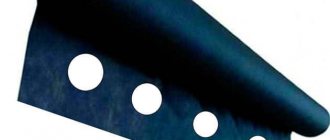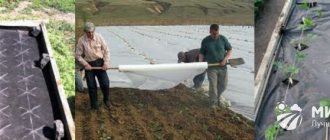Botanical description
The indoor ivy flower is a member of the Araliaceae family. According to various sources, the genus includes from six to 15 varieties. All of them grow mainly in mountainous areas - they use trees as supports and spread along the rocks.
Typical representatives of the genus are woody evergreen vines. They are fixed on the supports using special aerial roots that work like suction cups. As they grow, the stems thicken, become covered with bark, and turn into massive, uneven trunks.
The leaves are entire or three-five-lobed, depending on the variety. They are arranged alternately on the stem. Only mature plants over ten years old bloom. The flowers are small, yellow, with a greenish tint, collected in umbrella inflorescences. It is not possible to achieve flowering at home. The most common variety is hedera helix (common ivy).
There is a popular belief that hedera cannot be grown at home. Sometimes ivy is called “husband buster” - it is believed that the flower destroys marriages and forces a man to leave his family. But in Ancient Greece and Rome, ivy was a symbol of marital fidelity, and in the East - longevity. All signs associated with growing ivy at home are nothing more than superstitions.
Plant walking on the wall
Ivy is an evergreen climbing shrub from the Araliaceae family. Distributed throughout Southern Europe. Found in Crimea, Krasnodar Territory, Kaliningrad Region, and the Caucasus. It grows in deciduous forests, entwining trees like a vine, and in the mountains, climbing steep cliffs. The walls of buildings covered with ivy are an integral part of the European landscape in the countryside.
The stems are long lashes, which, when kept indoors, can reach a length of 6-15 m. Small aerial roots can be seen on them. They are not intended to feed the plant, but to move it. With the help of sucker roots, the hedera attaches to the support and begins its “journey.”
The leaves of the plant are dense, leathery, glossy, dark green or feathery. They have a three-, five- or seven-lobed shape. To better capture sunlight, the leaves are arranged in a mosaic pattern - in one plane. If there is too much light or not enough light, they begin to turn pale and lose their elasticity.
Hedera blooms mainly in natural conditions. Small greenish-yellow flowers are collected in umbrella-shaped inflorescences. They appear 7 or more years after planting. The flowers do not have a decorative function due to their unsightly appearance and unpleasant odor.
The fruits are small round berries, first green, then purple and black when fully ripe. They are poisonous to humans but harmless to birds, which happily eat them and then spread the seeds in their excrement.
Popular indoor species
Not all types of heder are common in indoor culture. Mainly three varieties are popular among gardeners.
- Ordinary. The most common type of ivy. The stems climb along the support or spread across the soil. Aerial roots are formed in large numbers. The leaves are three- to five-lobed, leathery, with a glossy surface. The veins are slightly lighter than the main shade and stand out clearly. There are hybrid varieties that differ in leaf shape and color.
- Canary. The variety grows the longest vines. The leaves are large, triangular, rich green. Variegated varieties with variegated leaf colors have been artificially bred.
- Colchis. The shoots are powerful, long, and easily twine around supports. The leaves are large, up to 25 cm long, solid in shape. It is distinguished by its beautiful emerald color and musky scent of leaves.
Hedera leaves are used in folk medicine to treat atherosclerosis, liver, gastrointestinal and lung diseases. Substances contained in ivy juice have anti-inflammatory, antifungal, and bactericidal effects.
Varieties of Hedera ivy
There are 15 species and about a hundred varieties of Hedera helix in the world. Most of the representatives of the genus are universal in their qualities and properties and can be grown both in open ground and indoors.
- Hedera canariensis - Canary ivy. Homeland - Portugal. Large-leaved variety without aerial roots. In its natural habitat it reaches 20-30 meters in length.
- Hedera helix "Goldheart". Belongs to the extensive Hedera chemical mix family. A variegated variety bred artificially. Large heart-shaped leaves with a whitish or yellowish central part. Goldhart is equally good at planting along walls for vertical gardening, and as a horizontal decoration for personal plots.
- Hedera helix "Hester". A rather rare variety with narrow long leaves, rarely growing more than 3 meters.
- Hedera helix Fatshedera lizei is the original result of crossing Fatsia japonica with Irish ivy. The Fatsheder hybrid retains its species characteristics only when propagated by root shoots.
- Hedera colchica - Colchis ivy. The leaf blade of Colchis ivy is considered the largest. An adult leaf grows up to 15 cm in diameter. The leaf length is 25-27 cm. Hedera colchica is the record holder for the longest flowering period. In the natural environment, flowering time begins in August and ends in late autumn.
- Hedera pastuchovii (Pastukhov's ivy). A rare variety listed in the Red Book. Unlike its brothers, it does not like rocks and stones - it prefers trees. The leaf is wedge-shaped, less often heart-shaped, no more than 9 cm in diameter.
- Hedera maderensis. Named after its homeland - the island of Madeira. Phytodesigners use one of the varieties of the variety, which has reddish-purple ellipsoidal leaves.
Caring for Hedera Helix and creating a favorable microclimate
Ivy grows quickly, easily adapts to apartment conditions, and is considered an unpretentious plant. The main difficulty lies in the need to shape it and the inconvenience of transplanting large adult specimens. How to organize care for indoor ivy at home in order to achieve its high decorative value? When growing vines in an apartment, they try to adhere to the following rules.
- Lighting. Ivy easily tolerates shading and does not like heat and sun. It grows fully on northern windows; the pot can be placed on the east and west sides. Variegated varieties are more demanding of light - the characteristic pattern of the variety is lost in the shade. In winter, additional lighting is provided.
- Temperature. Adapts normally to average room temperature. Temperatures above 25°C lead to lethargy and yellowing of leaves. Optimal keeping conditions are 20-23°C. Small specimens are taken out into the open air in the summer - ivy is not afraid of drafts and temperature changes. During the heating season, the hedera is placed at a distance from the radiators.
- Watering. It is a moisture-loving plant, so the hedera needs to be watered abundantly, especially in the warm season. In winter, reduce the amount of water per watering and the frequency of procedures - water only after the soil surface has dried by 2-3 cm. Use soft, settled water at room temperature. Stagnation of moisture is not allowed - this can damage the root system.
- Humidity. Large ivy leaves actively evaporate liquid. To compensate for its deficiency, hedera needs frequent spraying. When grown in conditions of high humidity, the color of the leaves becomes richer, the veins appear more clearly, branching and growth of green mass increase. Spray hedera only with soft water. Periodically, wipe the leaves with a damp cloth, install air humidifiers, and place bowls of water in hot weather. Small specimens can be bathed in the shower.
- Feeding. The rapid growth of the vine requires systematic application of fertilizers. Use ready-made mineral complexes for decorative foliage plants. In the warm season, fertilizers are applied at intervals of one and a half to two weeks. In winter, it is enough to feed once a month.
- The soil. Hedera can grow in almost any soil. The optimal soil for indoor ivy is a mixture of deciduous soil, peat, turf and river sand. The use of ready-made universal mixtures is allowed.
- Transfer. Young specimens are replanted frequently - annually. As they grow, the intervals between transplants increase. Each time the volume of the pot is increased slightly. In large, mature specimens, instead of replanting, the top layer of soil is replaced annually. The roots are superficial - the pot is wide and shallow. The bottom is covered with a layer of drainage material. When transplanting, preference is given to the transshipment method.
In reviews, experienced flower growers write that ivy is a good material for creative experiments. Some people graft hedera shoots onto fatsia, which belongs to the same family. The result is an unusual, willow-like tree.
Home care
A healthy, vigorous plant is characterized by bright leaf color, thick skin, flexible and elastic stems.
The leaves should be evenly distributed along the entire length of the stem. If it seems to you that the leaves are growing too rarely or too far from the roots, you most likely need to change the conditions of maintenance and care.
Pruning is also a good way to rejuvenate the plant and give it new strength.
The soil for the plant is usually purchased ready-made. Experienced English ivy gardeners often make their own potting mixture. There are many recipes for preparing soil, but they vary depending on the geographic area and the natural materials available.
It is best to feed ivy with 50% liquid fertilizer for houseplants. The frequency of fertilizing depends on the condition of the flower; the average value is once every 3 or 4 months.
How to care immediately after purchase?
For this plant, choose a cool, well-lit place. If it is a windowsill, make sure that the plants are protected from drafts.
Due to the fact that ivy vines decorate the room, a flower pot is often placed higher: at the level of human height, for example. Often this decision is justified, since in this position good illumination is provided. However, it is more difficult to monitor the condition of the plant, soil moisture and leaf color. Read more about caring for ivy here.
Trimming
In mid-spring, you can prune an overgrown plant. This procedure will only strengthen the health and endurance of the ivy. The resulting branches - shoots - easily take root and give rise to new plants.
Watering
Like most plants, the life cycle of ivy is divided into vegetative - a period of intensive growth and a period of rest, or wintering.
In the cold season, watering is reduced to a minimum, but as daylight hours increase, they carefully return to the normal regime.
During the growing season, ivy should be watered relatively often to keep the soil slightly moist.
In summer, when it’s hot, it’s good to spray the plant. Ivy loves moist air and fog, natural or artificial. In addition, in the summer, when the windows are open, a lot of dust can quickly accumulate on the leaves. It is enough to wipe the leaves with clean water 1-2 times a week using any soft cloth or sponge.
Temperature
Loves moderate temperatures and thrives in cool rooms.
Hypothermia may be indicated by the appearance of a light pinkish border along the edges of the leaves.
The recommended range is from +10 to +18˚С, the minimum permissible value is +5˚С.
Lighting
The plant loves fairly bright, but soft light - diffused, as in a forest or other natural conditions. Direct rays of the sun have a harmful effect on ivy.
Lack of lighting is reflected in the fact that the leaves begin to lose their light spots and patterns: they turn pale, blur at the edges and gradually disappear. In general, variegated ivy species require more light than solid green ivy plants.
If you notice that the pattern on the leaves has lost its clarity, move the flower to a dark corner for a day or two, and then place it in a brightly lit place. Light fabrics are best protected from direct rays of the sun; you can use frosted glass or a tissue paper screen.
IMPORTANT! Signs that your ivy is not feeling well may indicate improper lighting or other problems, such as improper soil composition or too much watering.
Trimming and shaping
To form a beautiful bush shape, the heder needs to be pruned periodically. The optimal time for pruning is mid-spring. Remove all bare shoots that have lost their decorative appearance. Too long lashes are shortened by a third or half. The length of all shoots after pruning should be approximately the same.
The bush is formed in the form of an ampelous plant or a climbing vine. In the first case, the hedera is planted in hanging pots, and the length of the vines is adjusted by pruning. In the second case, ropes are pulled, special supports or decorative grilles are used. When grown as a climbing vine, they immediately find the optimal, permanent place - it will not be possible to remove the plant from its supports without damage.
Landing
Beginners in floriculture can easily cope with planting ivy. Indoor ivy is not a fussy plant and grows quickly. Very worthy fruits of labor can be seen in a year.
The task is to plant the young plant in a pot and form its shoots on a support. For planting, flower growers recommend not buying a plant in a pot from the store, but taking cuttings from an adult viable flower from friends. The cuttings are placed in water where they should take root. To move it into the ground, just wait until the roots appear 1-2 cm.
For planting you need a pot and supports. To grow a tall decorative composition of climbing vines, you will need a pot with a capacity of at least 5 liters. The ivy pot or container is a cone that widens towards the top (an inverted pyramid).
The container is filled with soil, having previously laid a layer of drainage. If you intend to plant several cuttings in one tank, you should maintain a distance between them of at least 15 cm. In order for the cuttings to take root quickly and thoroughly, they must be immediately tied to supports. When the shoots of the cuttings begin to lengthen, they are twisted around the supports, forming a flower at their own discretion.
You can water indoor ivy immediately after planting.
Reproduction methods
Indoor ivy can be propagated vegetatively and by seeds. Seed propagation is complicated by the inability to obtain planting material from one's own plant and the slow growth of seedlings. Therefore, three methods of vegetative propagation are most often used.
By shoots
An effective propagation method that allows you to get several seedlings from one shoot. Planting is carried out in the following sequence of actions.
- Choosing and preparing an escape. Choose a healthy shoot with ten leaves. On one side of the stem, along the entire length, a longitudinal cut is made. To accelerate growth, it is treated with a root formation stimulator.
- Landing. The shoot is laid horizontally, cut side down, on moistened sand. Cover the top with sand in a layer of about 2 cm.
- Care. Keep in a moderately warm place, moisten the sand from time to time, maintaining constant humidity. After a couple of weeks, young shoots appear.
- Transfer. The shoot is taken out of the sand and divided into several parts. Part of the root system and at least one leaf are left on each segment. The resulting seedlings can be planted in separate pots or planted three or four in one container.
Cuttings
Cut apical and stem cuttings about 10 cm long. Under suitable conditions, the cuttings quickly produce roots. There are two ways to root them.
- In the ground. The base of the cuttings is dipped in a root former solution and immersed in soil consisting of sand and forest soil. Cover the top with a jar or make a polyethylene greenhouse. Maintain moderate soil moisture and temperature at 16-22°C. After signs of growth appear, the shelter is removed and the cuttings are transplanted to a permanent place.
- In water. Boiled water is poured into a glass, an activated carbon tablet and a little of any root former are added. Sprout in a warm place, with moderate lighting. After the roots appear, they are planted in the ground.
By shoots
Reproduction by shoots is similar to rooting of a shoot. Select a healthy shoot and make a longitudinal incision. The branch is not cut off from the mother plant; it is buried in the same or another pot. Within two weeks, roots form on the stem and shoots appear. They are carefully separated and planted.
The seed method is used mainly for growing new hybrid varieties. The seeds are wrapped in cloth, dipped in a weak solution of a growth stimulator and left for two days. The swollen seeds are planted in small pots and covered with film. Before germination, maintain the temperature at 23-28°C.
Precautionary measures
Hedera is very poisonous. Its fruits, which look like greenish umbrellas, are especially dangerous. When taken orally in their pure form, they cause serious poisoning. Therefore, the plant should be kept where children and pets cannot reach it.
Important! Do not allow your pets to eat leaves of indoor ivy: this is likely to lead to death.
It is better to care for the plant by wearing rubber gloves. Particularly sensitive skin may develop an allergic rash if you trim the hedera or cut a stem from it with your bare hands.
Difficulties of growing
Uneven watering, low air humidity and incorrectly selected feeding regime lead to a decrease in the decorativeness of ivy. You can determine which maintenance conditions are violated by the appearance of the plant. The main growing difficulties are summarized in the table.
Table - Problems when growing hedera
| Appearance of the plant | Main reasons | Help the plant |
| Indoor ivy dries, leaves turn brown | - Heat; - dry air; - irregular, poor watering; - pest damage | - Adjustment of detention conditions; - spray more often; - inspect for pests |
| Stems become bent, become bare, leaves become smaller | Insufficient lighting | - If possible, move to a brighter place; — organize additional lighting |
| Leaves turn yellow and wither | — Poor, irregular watering; - excess fertilizer | - In summer, water frequently and abundantly; - sprayed daily; — fertilizers are applied in accordance with the instructions for the preparation |
| The ends of the leaves dry out and turn brown | — Low air humidity; - heat; - dry soil | In hot weather, water and spray more often |
| The lower leaves are falling | Natural process | They don't do anything |
| Massive leaf fall begins | — Dry air; - appearance of pests; - rotting of the root system | - Increases humidity in the room; - spray ivy daily; — inspect for the presence of pests; - replant with pruning of damaged roots |
Soils for planting
A slightly acidic nutrient soil mixture is suitable for planting the plant. If the soil is purchased at a flower shop, you should give preference to a universal mixture or a mixture for ornamental plants. Specialized soils are suitable for indoor ivy: “Schefflera”, “Begonia” or “Geranium”.
To prepare the earthen mixture yourself, you need to maintain the following proportion:
- 1 part leaf soil;
- 1 part coarse river sand;
- 1 part peat;
- 2 parts of turf land.
The drainage function is performed by expanded clay or pebbles. The bottom of the pot is lined with a drainage layer; such measures prevent stagnation of water in the root zone.
Diseases and pests
Most houseplant diseases are not harmful to ivy. Occasionally you have to deal with gray rot. The development of the disease is provoked by excessive dampness and stagnation of air. At the initial stage, a fluffy gray coating appears on the leaves and stems. Immediately cut off all affected tissues and treat with fungicidal agents. If the infection is severe, the plant dies.
Pests cause more trouble. Especially often you have to deal with spider mites, scale insects, and thrips. Pests can be recognized in the initial stages by a number of signs. They are described in detail in the table.
Table - Hedera pests
| Pest | Signs of infection | Ways to fight |
| Common spider mite | - Yellowish specks appear on the upper side of the leaves; - the leaves become marbled in color, turn yellow and fall off; - the plant is entwined with a thin white web | - Increases humidity in the room; — young specimens are bathed in the shower and kept in a bathroom filled with warm steam for several hours; - adult bushes are often sprayed; - treated with Aktara |
| Red spider mite | — Uneven gray-brown spots appear on the skin of non-lignified sections of the stem; - the plant withers and dies | |
| Mealybug | — White fluffy lumps appear along the veins, resembling cotton wool; - leaves, petioles and stems become covered with a waxy whitish coating; - growth slows down | — Spray the plant with a weak alcohol solution; - severely affected branches are washed with water and green potassium soap; - treated with any systemic insecticide |
| Shields | — A cluster of insects with hard shields forms along the veins on the leaves; - leaves become covered with honeydew - sticky secretions of pests; - sooty fungus develops | — Insects are collected by hand; - sprayed with “Aktellik”, “Iskra”, “Inta-vir” |
| Greenhouse thrips | - Whitish spots appear on the upper side of the leaves, brown spots on the lower side; - leaves turn yellow, dry out, fall off | — Increase humidity; - sprayed several times with any insecticide at weekly intervals |
| Aphid | — Colonies of green, gray or black insects form on the underside of leaves and young shoots; — leaves become deformed, curled, and become sticky | — The affected branches are washed with a soapy sponge; - sprayed with a solution of the drug with permethrin |
Caring for a hedera flower is not difficult at all. Ivy is used for landscaping apartments and offices. Valued for its unpretentiousness and rapid growth. Due to the abundance of large leaves, it is considered a good air purifier.

